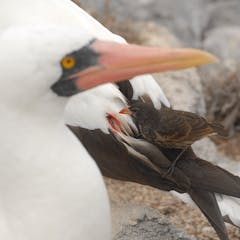
Articles on Evolution
Displaying 261 - 280 of 988 articles

First published 150 years ago, this work is shaped by Victorian-era sexual and racial stereotypes. But at a time when other evolutionists stressed humanity’s uniqueness, Darwin emphasised our ‘lowly nature’.

Our results have revolutionised the previously held view of the evolution of mammoths.

The stench was once thought to originate from plants, but scientists have now pin-pointed its true origin.

Through a bee’s eyes, blue flowers are more common than you’d think — and they could be used to monitor environmental health.

A reconstruction of a dinosaur’s back passage reveals it may have been used for visual communication.

Multiple COVID-19 variants are circulating around the world and becoming more common. These mutations can alter the ability of the virus to take hold and replicate within our cells.

A toxin unique to spitting cobras means their venom causes more pain than other snakes.

New study sheds light on how the starfish evolved.

Even the most mutually-beneficial evolutionary relationship can turn sour.

A biologist who studies the evolution of diseases explains what’s different about the two new virus strains that have been found recently, and what that means for vaccine effectiveness.

Finches have evolved to feed off blood from red-footed and Nazca boobies – and we’ve seen it first-hand.

For the past 50 years, international animal cognition research has focused on how tool use is related to animal intelligence. But new research casts doubt on long-held assumptions.

Our research shows dire wolves lived in the tropics not the Arctic, and were not especially close relatives of the grey wolf.

New research shows crocodiles have landed upon an equilibrium state of evolution.

Transparency is an evolved characteristic of some species to help them survive, even when predators are staring directly at them.

Species can evolve to tolerate higher temperatures – but there’s a ceiling beyond which adaptation isn’t possible.

When allocating resources, we prioritize members of the social groups we belong to, rather than including others in our allocations. This will determine how the COVID-19 vaccine is distributed.

Over the past ten years, scientists have argued about what the earliest animal really was.

Ten years ago, we feared Tasmanian devils would be wiped out by a bizarre infectious facial cancer transmitted by biting. But new genetic analysis shows they are evolving to live with the disease.

‘Worm’ is really a catchall term for a huge variety of animals with different characteristics that span the tree of life. They hold clues about our own origins as well as hints about human health.
